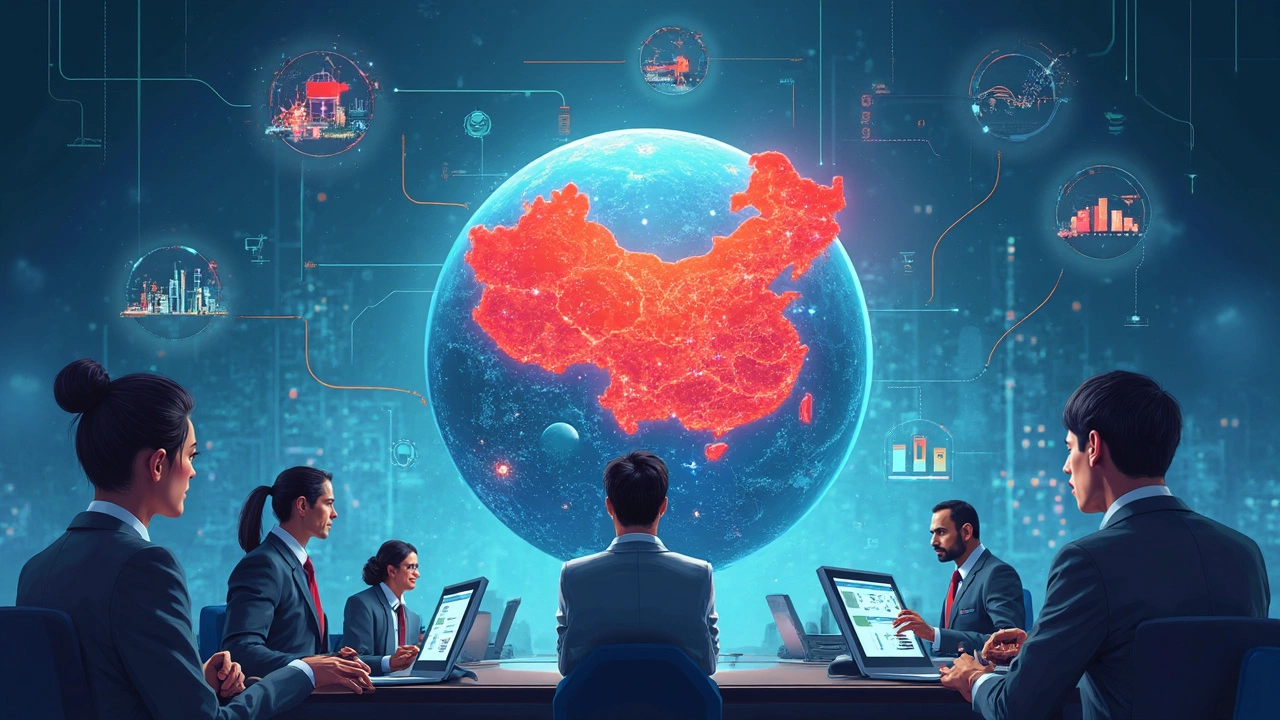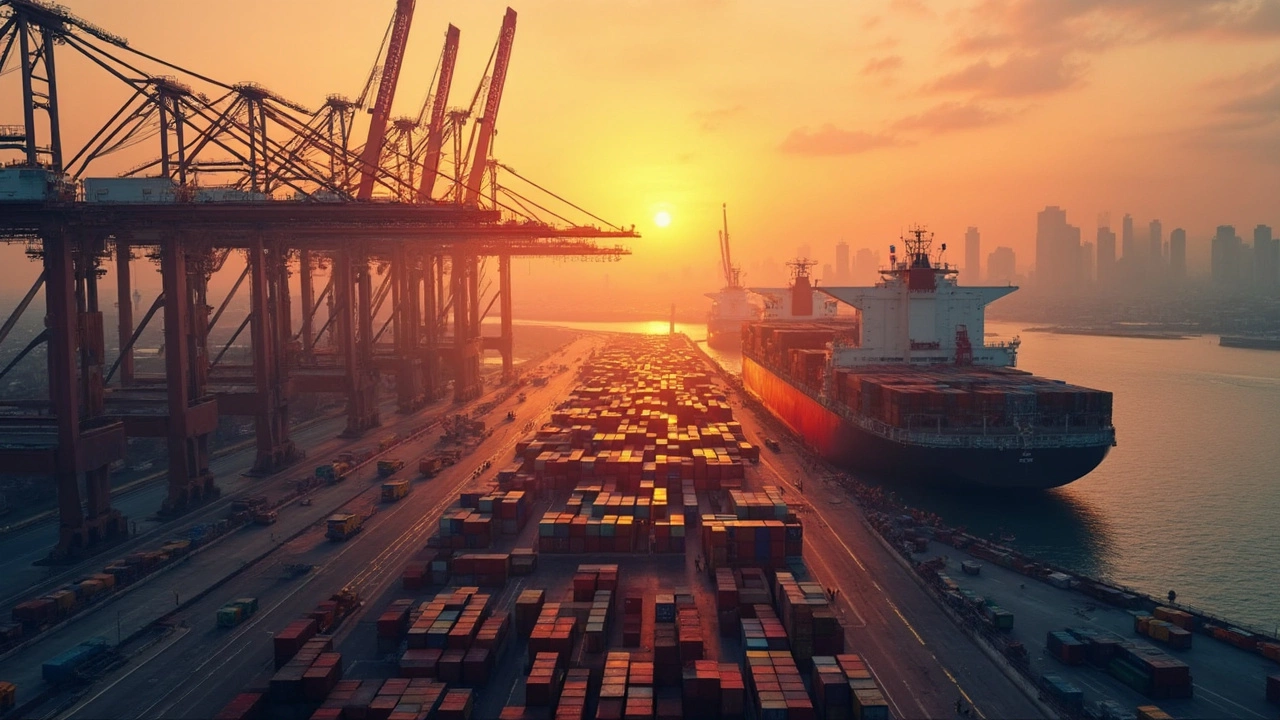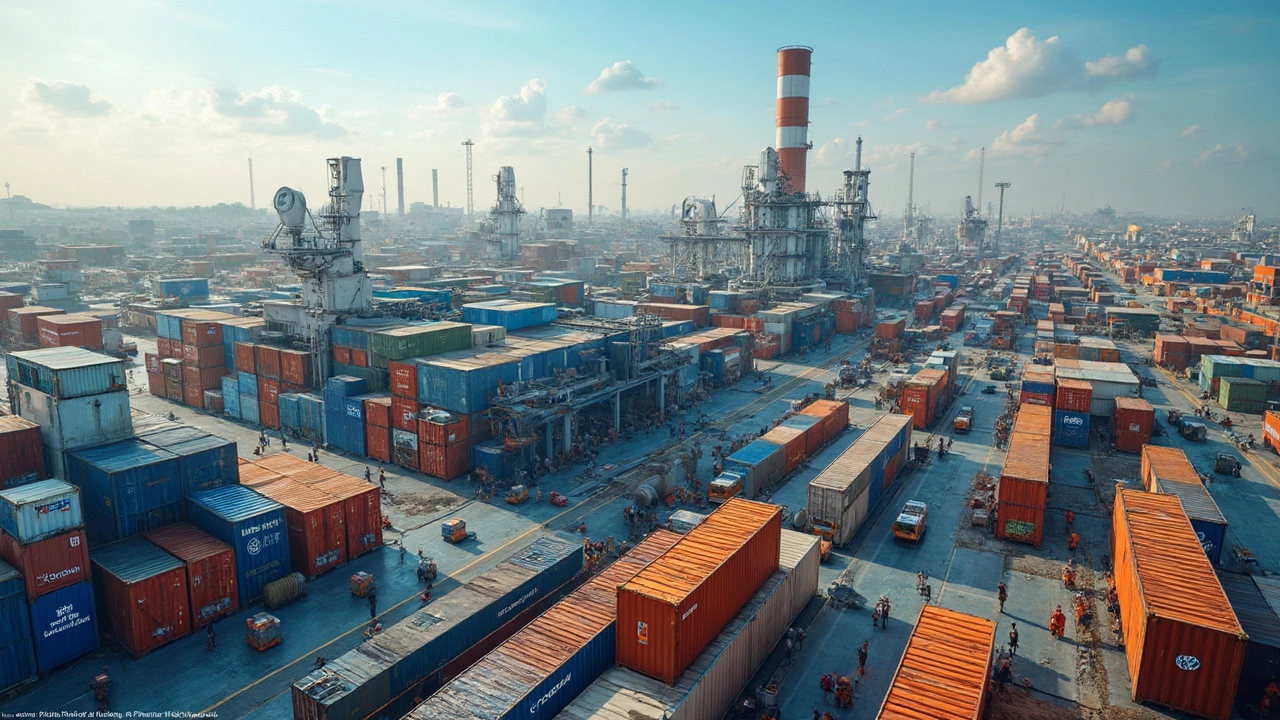Ever wonder who actually makes the world's stuff? Not just gadgets but cars, clothes, kitchen mixers, even your favorite snacks. When it comes down to brass tacks, the biggest manufacturer in the world controls more than just production lines—they shape global trade, affect jobs across continents, and even tweak what lands on your shopping list. The scale is almost impossible to imagine until you see the sheer numbers: factories the size of cities, workers that could fill a stadium every day, and a footprint that stretches from South America to Southeast Asia. But here's the kicker: it’s not just about size. Innovation, automation, and even politics play huge roles in crowning the real kings of manufacturing. Let's pull back the curtain to see who sits on top, why they got there, and how their decisions make waves in everything from your wallet to the shape of tomorrow's cities.
What Makes a Manufacturing Giant?
The title of biggest manufacturer has a lot riding on it—it means you not only crank out incredible amounts of physical goods but also shape how the rest of the planet lives and works. So what goes into this title? For starters, sheer output matters, often measured in total revenue, volume of goods produced, or sheer physical reach. Take China, for example. No one even comes close when it comes to scale. According to the World Bank’s 2024 report, China singlehandedly accounted for more than 28.6% of the world’s manufacturing output, leaving the United States and Germany in the dust. What’s wild is that just in the city of Shenzhen— where Foxconn’s famous mega-factory churns out iPhones and gaming consoles—more gadgets are created daily than in most European countries combined.
But numbers aren’t the whole story. Tech adoption is massive. The integration of AI, robotics, and just-in-time logistics means that the old school, smokestack image barely holds up anymore. Take Foxconn again. They were among the first to roll out tens of thousands of industrial robots, cutting costs and boosting precision at jaw-dropping speeds. The company could now plausibly switch from building smartphones to wearable devices literally overnight, thanks to modular design lines—a far cry from the days when retooling meant months of downtime. Key players like Toyota and Volkswagen set global standards for lean manufacturing and quality control, raising the bar for everyone else around the globe. And yes, supply chain resilience became a top priority after the COVID pandemic taught everyone just how quickly a single component shortage could halt entire industries.
Access to raw materials and energy, government policies, and strategic logistics routes add more weight. Companies with the power to negotiate cheap inputs and shipping control value chains from source to shelf. Throw in automation, economies of scale, and clever tax strategies, and it’s a recipe for unstoppable dominance—if you play your cards right. The big names don’t just compete on price. They shape environmental standards, labor practices, and even international law, creating ripple effects that run right down to the consumer. That’s why understanding what makes someone the largest manufacturer on earth goes way beyond just how many widgets they make.
If you’re eyeing list-makers from Fortune or Forbes, you’ll see the same usual suspects year after year: Volkswagen Group, Foxconn, Toyota, and Samsung Electronics. The numbers are wild. In 2024, Volkswagen reportedly produced almost 9 million vehicles across dozens of countries, while Foxconn’s workforce created electronics at an even higher clip. You’ll also find companies in chemicals, machine parts, and even food processing, proving that manufacturing isn’t all about steel and engines.
China: The World’s Workshop
When the topic is the world’s biggest manufacturing spot, China’s dominance is just off the charts. For years, every label that read "Made in China" wasn’t just a running joke—it marked the country’s stamp on nearly every consumer product you could imagine. The stats aren’t even close. As late as last year, China’s total manufacturing output hit over $4.9 trillion, wiping the floor with any competitor. From plastics and textiles to automobiles and advanced electronics, if you have something in your house, it probably began its life in a Chinese factory.
What really turbocharged China’s manufacturing sector? It wasn’t just cheap labor or vast populations, but clever investments in infrastructure and education. Entire regions like Guangdong or the Yangtze River Delta run on manufacturing power, with giant cities like Shenzhen and Suzhou built almost entirely around industrial ecosystems. China churns out more steel and cement than the next five countries combined; it assembles more smartphones and laptops than anywhere else; and it also makes the bulk of the world’s solar panels and electric vehicle batteries, positioning itself as a green tech leader. The International Monetary Fund noted that in 2023 alone, China produced 85% of the world’s air conditioners and over 65% of its semiconductors by volume.
| Country | 2024 Manufacturing Output (USD trillions) | Share of Global Output (%) |
|---|---|---|
| China | 4.9 | 28.6 |
| United States | 2.5 | 15.1 |
| Japan | 1.1 | 6.4 |
| Germany | 1.0 | 6.2 |
| South Korea | 0.7 | 3.8 |
The "Made in China" story is not frozen in time—workers are now better trained, supply chains more sophisticated, and more manufacturing has shifted to higher value products. Factories powered by green energy and staffed by skilled engineers have replaced many sweatshops. You see electric cars and wind turbines lining up alongside cheap toys and t-shirts. Now, Chinese manufacturers are leaping ahead in robotics, AI-driven logistics, and advanced material science. The country isn’t just a middleman for assembly anymore; it’s designing, innovating, and patenting at crazy speeds.
Still, there’s a downside. Heavy pollution, worker rights concerns, and overcapacity are big headaches. To stay ahead, China is investing in "dual circulation"—balancing exports with more domestic consumption and high-tech innovation. Don’t expect their lead to drop anytime soon, though. Even as rising wages and geopolitics push some manufacturers into Southeast Asia, China’s super-fast rail, port networks, and relentless focus on productivity keep it far out in front.

Meet the Corporate Heavyweights: Foxconn, Volkswagen, Toyota, and More
Sure, whole countries can earn "biggest manufacturer" bragging rights, but when you zoom in, single companies can wield power bigger than many nations. For tech, Foxconn (or Hon Hai Precision Industry) is the gorilla in the room. With factories sprawling across China, India, and even North America, Foxconn employs over a million people. In their peak production phase, one of their mega plants can pump out up to 500,000 iPhones a day. But Foxconn’s reach goes way beyond Apple; they also build, assemble, and design gadgets for Sony, Microsoft, and just about every big electronics brand out there.
Auto is its own animal, and here Germany’s Volkswagen Group rules. In 2024, the group made about 9 million vehicles—think everything from speed-hungry Audis to elegant Bentleys and popular VWs. What sets VW apart is this cunning supply chain mastery—factories that swap out product lines in days, allow customizations on crazy short notice, and dice up manufacturing across continents so local plants can dodge tariffs and changing laws. Their reach—spanning over 150 manufacturing sites in 27 countries—puts them in a league of their own. Toyota, meanwhile, isn’t far behind, with its rock-solid reputation for reliability and lean production. Back in 2023, their yearly output sailed past 10 million vehicles. Their "just-in-time" system is a playbook for efficiency, with every nut and bolt tracked, and every step clocked for tightness.
Heavy industries have their own titans. Think of ArcelorMittal in steel, BASF in chemicals, or Samsung for high-tech components. South Korea’s Samsung Electronics—yep, the folks behind your fridge and your phone—poured $48 billion in 2024 into research and development, staying ahead on semiconductors, flexible displays, and smart appliances. GE (General Electric) is still a huge player too, spanning jet engines, wind turbines, and all sorts of heavy equipment. You might be surprised: Nestle cracks into the top tier for sheer volume of packaged foods.
Let’s break down some real facts with a table detailing a handful of manufacturing giants and what they specialize in:
| Company | Sector | 2024 Revenue (USD billions) | Employees |
|---|---|---|---|
| Foxconn (Hon Hai) | Electronics | 206 | 1,290,000 |
| Volkswagen Group | Automotive | 314 | 667,000 |
| Toyota | Automotive | 273 | 372,000 |
| Samsung Electronics | Tech Components | 246 | 111,000 |
| ArcelorMittal | Steel | 79 | 154,000 |
Want to know how all this affects your everyday life? Chances are, the car you drive and the phone in your pocket trace some part of their story to these manufacturing champions.
Innovations and the Changing Face of Manufacturing
Manufacturing used to mean big smokestacks, repetitive work, and walls of machines. Now? The face is high-tech, nimble, and constantly evolving. The last decade saw an explosion in automation, with robotics and AI muscling in on factory floors everywhere. The World Economic Forum clocked over 2 million industrial robots operating globally as of 2024, with China alone adding over 350,000 new robots last year. Production lines shift between products faster than ever—think how Foxconn can go from making game consoles to virtual reality headsets in just weeks. Flexibility is king, and digital twins—virtual versions of production lines—let companies test, tweak, and launch new products at record speeds, without ever shutting down the real world line.
3D printing, once just for hobbyists, has gone truly industrial. Companies like GE Aviation are now printing metal jet engine parts that are lighter, cheaper, and just as strong as their traditional counterparts. Supply chains, once long and sprawling, are tightening up thanks to "reshoring"—moving some production closer to where stuff’s actually sold. Toyota and General Motors started building more vehicles and parts inside North America, cutting down on COVID-era delays and risks. Then there’s the push for clean and green: big players are swapping fossil fuels for renewable energy, making factories run on solar and wind, and limiting emissions. Tesla’s gigafactories are a crash course in how electrification and automation can get crammed under one massive roof.
Customer demands are shifting things too. People want custom products—shoes that fit their exact style, cars with unique features, or electronics in any color and shape they dream up. Ecosystems are being built where mass production and personalization blend. Nike’s factories now use real-time data to customize sneakers, while big car brands offer "build-your-own" models online, then crank them out in agile plants. Even the boring stuff—like packaging—is seeing a makeover as sustainability rules get stricter and consumers push for less waste.
Talent is changing as well. The workers running these massive operations don’t just wrench bolts—they program software, maintain robots, and troubleshoot digital systems. Factories are set up for lifelong learning; workers train on virtual reality simulators or learn to operate new equipment from tablets instead of manuals. The line between blue collar and tech worker keeps blurring. As US and EU governments bump up tariffs and try to revive domestic manufacturing, the advantage goes to the companies who can adapt quickly, automate smartly, and pivot without missing a beat.

The Race Ahead: Who Will Dominate Tomorrow?
With so many factors in play, the biggest manufacturer’s crown could shift in a heartbeat. China sits securely atop the world’s rankings for now, but the landscape is changing fast. US and European firms are hurrying to reclaim lost ground by investing in next-generation tech, cleaner production lines, and high-value products. Southeast Asia offers cheaper labor and new industrial hubs, with Vietnam, Thailand, and Indonesia pulling in more of the jobs that once drove China’s rise.
Tech’s role can’t be understated. Whoever masters AI-driven design, ultra-fast logistics, and seamless factory connectivity will stay ahead. For companies, agility and innovation matter as much as brute scale. Foxconn plans to expand further into electric vehicles and health tech. Volkswagen bets big on electric cars and digital self-driving platforms. Samsung is hunting for dominance in next-generation chips, hoping to push ahead of rivals like TSMC in Taiwan. The shape of manufacturing keeps morphing because the market, technology, and global politics won’t sit still.
Geopolitics throws curveballs too. Trade wars, sanctions, and supply chain risks push companies to become more self-sufficient and flexible. COVID-19 made everyone realize that just-in-time can mean "just too late" if borders slam shut. Manufacturing bigwigs are investing in "redundant" supply paths—multiple sources for every key part, backup plants in different countries, and deep stockpiles of crucial materials. The race is less about who is biggest right now and more about who can weather the next big shock and still deliver the goods.
So next time you check a label or power up your phone, remember: it likely traces back to an invisible web spun by some of the world’s largest manufacturing titans. Whether it’s China’s factories, Volkswagen’s car plants, Foxconn’s electronics lines, or the next tech breakthrough from a yet-unknown rival, these powerhouses make the world tick—one assembly line at a time.
